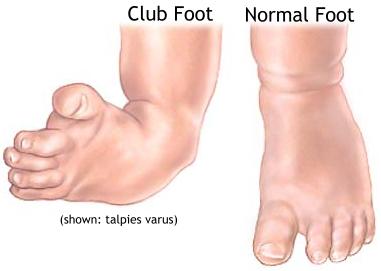Clubfoot Causes, Symptoms, Diagnosis and Treatment

What Is Clubfoot?
Also called congenital talipes equinovarus (CTEV), clubfoot is a congenital deformity involving one foot or both.The affected foot appears to have been rotated internally at the ankle.
It can range from mild to severe. Approximately, half of those affected by clubfoot develop it in both feet (a severe case).
Clubfoot itself can lead to the development of serious complications:
- Arthritis
- Poor self-image
The unusual appearance of foot can lead to low self-esteem, depression and lack of self-worth. - Inability to walk normally
- Muscle development problems, leading to awkward gait
Causes Of Clubfoot:
Although the underlying cause of clubfoot is yet unknown, Scientists link clubfoot to the position of fetus in the womb. This is also called postural clubfoot.
Other than this, Clubfoot is caused by a combination of genetic and environmental factors. However, the contribution of these factors to the cause is not yet fully understood.
Certain factors increase the risk of developing clubfoot. Such factors may include:
- Being male
- Having family history of clubfoot
- Smoking during pregnancy.
Smoking during pregnancy can lead to 20 times greater risk of developing clubfoot - Not enough amniotic fluid during pregnancy.
Too little of the fluid that surrounds the baby in the womb may increase the risk of clubfoot. - Getting an infection or using illicit drugs during pregnancy
Symptoms Of Clubfoot:
The only symptoms of clubfoot is the unusual appearance of the affected individual’s feet.
The characteristics of unusual appearance of the feet may include:
- The top of the foot is usually twisted downward and inward, increasing the arch and turning the heel inward.
- The foot may be turned so severely that it actually looks as if it’s upside down.
- The calf muscles in the affected leg are usually underdeveloped.
- The affected foot may be up to 1/2 inch shorter than the other foot.
Diagnosis Of Clubfoot:
Clubfoot is usually diagnosed immediately after birth simply by looking at the foot.
The following tests may be conducted to study the extent or severity of clubfoot:
- MRI
- X-ray
- Blood tests, to find the cause
Treatment Of Clubfoot:
There are three methods which may help in treating clubfoot.
They include:
- Ponseti method
- The foot is repositioned to the normal position then a cast (the “Ponseti cast”) is placed on top of it.
- The baby’s foot is then continually repositioned and placed back into a cast once a week for several months.
- Towards the end of the process after being in a cast, the doctor will then surgically lengthen the heel cod.
- French method
- The child’s foot is gradually stretched to achieve the right position, being held in place with tape after stretching.
- In the evening, the child’s foot is hooked up to a machine where it continuously moves the foot while the child sleeps
- Surgery
By : Natural Health News




